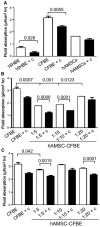Correction of defective CFTR/ENaC function and tightness of cystic fibrosis airway epithelium by amniotic mesenchymal stromal (stem) cells
- PMID: 24894806
- PMCID: PMC4190909
- DOI: 10.1111/jcmm.12303
Correction of defective CFTR/ENaC function and tightness of cystic fibrosis airway epithelium by amniotic mesenchymal stromal (stem) cells
Abstract
Cystic fibrosis (CF) is caused by mutations in the CF transmembrane conductance regulator (CFTR) gene, with most of the mortality given by the lung disease. Human amniotic mesenchymal stromal (stem) cells (hAMSCs) hold great promise for regenerative medicine in the field of lung disease; however, their potential as therapeutics for CF lung disease has not been fully explored. In the present study, hAMSCs were analysed in co-cultures on Transwell filters with CF immortalized airway epithelial cells (CFBE41o- line) at different ratios to exploit their potency to resume basic defects associated with CF. The results show that F-actin content was increased in co-cultures as compared with CF cells and actin was reorganized to form stress fibres. Confocal microscopy studies revealed that co-cultures had a tendency of increased expression of occludin and ZO-1 at the intercellular borders, paralleled by a decrease in dextran permeability, suggestive of more organized tight junctions (TJs). Spectrofluorometric analysis of CFTR function demonstrated that hAMSC-CFBE co-cultures resumed chloride transport, in line with the appearance of the mature Band C of CFTR protein by Western blotting. Moreover, hAMSC-CFBE co-cultures, at a 1:5 ratio, showed a decrease in fluid absorption, as opposed to CFBE cell monolayers that displayed a great rate of fluid resorption from the apical side. Our data show that human amniotic MSCs can be used in co-culture with CF respiratory epithelial cells to model their engraftment into the airways and have the potential to resume a tight epithelium with partial correction of the CF phenotype.
Keywords: CFTR; ENaC; actin; amniotic membrane; cell therapy; mesenchymal stromal cells; tight junctions.
© 2014 The Authors. Journal of Cellular and Molecular Medicine published by John Wiley & Sons Ltd and Foundation for Cellular and Molecular Medicine.
Figures






Similar articles
-
Amniotic mesenchymal stem cells: a new source for hepatocyte-like cells and induction of CFTR expression by coculture with cystic fibrosis airway epithelial cells.J Biomed Biotechnol. 2012;2012:575471. doi: 10.1155/2012/575471. Epub 2012 Jan 22. J Biomed Biotechnol. 2012. PMID: 22315512 Free PMC article.
-
The effect of ambroxol on chloride transport, CFTR and ENaC in cystic fibrosis airway epithelial cells.Cell Biol Int. 2013 Nov;37(11):1149-56. doi: 10.1002/cbin.10146. Epub 2013 Jul 23. Cell Biol Int. 2013. PMID: 23765701
-
NHERF1 and CFTR restore tight junction organisation and function in cystic fibrosis airway epithelial cells: role of ezrin and the RhoA/ROCK pathway.Lab Invest. 2012 Nov;92(11):1527-40. doi: 10.1038/labinvest.2012.123. Epub 2012 Sep 10. Lab Invest. 2012. PMID: 22964850
-
Emerging relationship between CFTR, actin and tight junction organization in cystic fibrosis airway epithelium.Histol Histopathol. 2017 May;32(5):445-459. doi: 10.14670/HH-11-842. Epub 2016 Nov 11. Histol Histopathol. 2017. PMID: 27834058 Review.
-
Liquid movement across the surface epithelium of large airways.Respir Physiol Neurobiol. 2007 Dec 15;159(3):256-70. doi: 10.1016/j.resp.2007.06.005. Epub 2007 Jun 17. Respir Physiol Neurobiol. 2007. PMID: 17692578 Free PMC article. Review.
Cited by
-
Cell-Based Therapeutic Approaches for Cystic Fibrosis.Int J Mol Sci. 2020 Jul 23;21(15):5219. doi: 10.3390/ijms21155219. Int J Mol Sci. 2020. PMID: 32718005 Free PMC article. Review.
-
Stem Cell-Based Therapeutic Approaches in Genetic Diseases.Adv Exp Med Biol. 2023;1436:19-53. doi: 10.1007/5584_2023_761. Adv Exp Med Biol. 2023. PMID: 36735185
-
miRNA Reference Genes in Extracellular Vesicles Released from Amniotic Membrane-Derived Mesenchymal Stromal Cells.Pharmaceutics. 2020 Apr 11;12(4):347. doi: 10.3390/pharmaceutics12040347. Pharmaceutics. 2020. PMID: 32290510 Free PMC article.
-
Native matrix-based human lung alveolar tissue model in vitro: studies of the reparatory actions of mesenchymal stem cells.Cytotechnology. 2017 Feb;69(1):1-17. doi: 10.1007/s10616-016-0021-z. Epub 2016 Dec 1. Cytotechnology. 2017. PMID: 27905026 Free PMC article.
-
Human Cellular Models for the Investigation of Lung Inflammation and Mucus Production in Cystic Fibrosis.Anal Cell Pathol (Amst). 2018 Nov 15;2018:3839803. doi: 10.1155/2018/3839803. eCollection 2018. Anal Cell Pathol (Amst). 2018. PMID: 30581723 Free PMC article. Review.
References
-
- Sheppard DN, Welsh MJ. Structure and function of the CFTR chloride channel. Physiol Rev. 1999;79:S23–45. - PubMed
-
- Matsui H, Grubb BR, Tarran R, et al. Evidence for periciliary liquid layer depletion, not abnormal ion composition, in the pathogenesis of cystic fibrosis airway disease. Cell. 1998;95:1005–15. - PubMed
-
- Donaldson SH, Poligone EG, Stutts MJ. CFTR regulation of ENaC. Methods Mol Med. 2002;70:343–64. - PubMed
-
- Griesenbach U, Alton EWFW. Cystic fibrosis gene therapy: successes, failures and hopes for the future. Exp Rev Resp Med. 2009;3:363–71. - PubMed
Publication types
MeSH terms
Substances
LinkOut - more resources
Full Text Sources
Other Literature Sources
Medical

